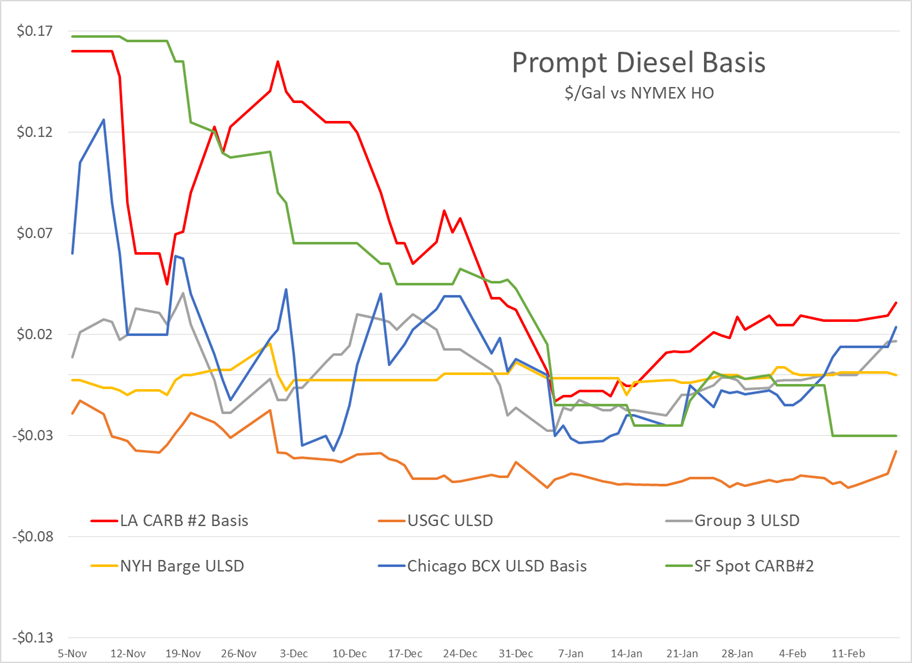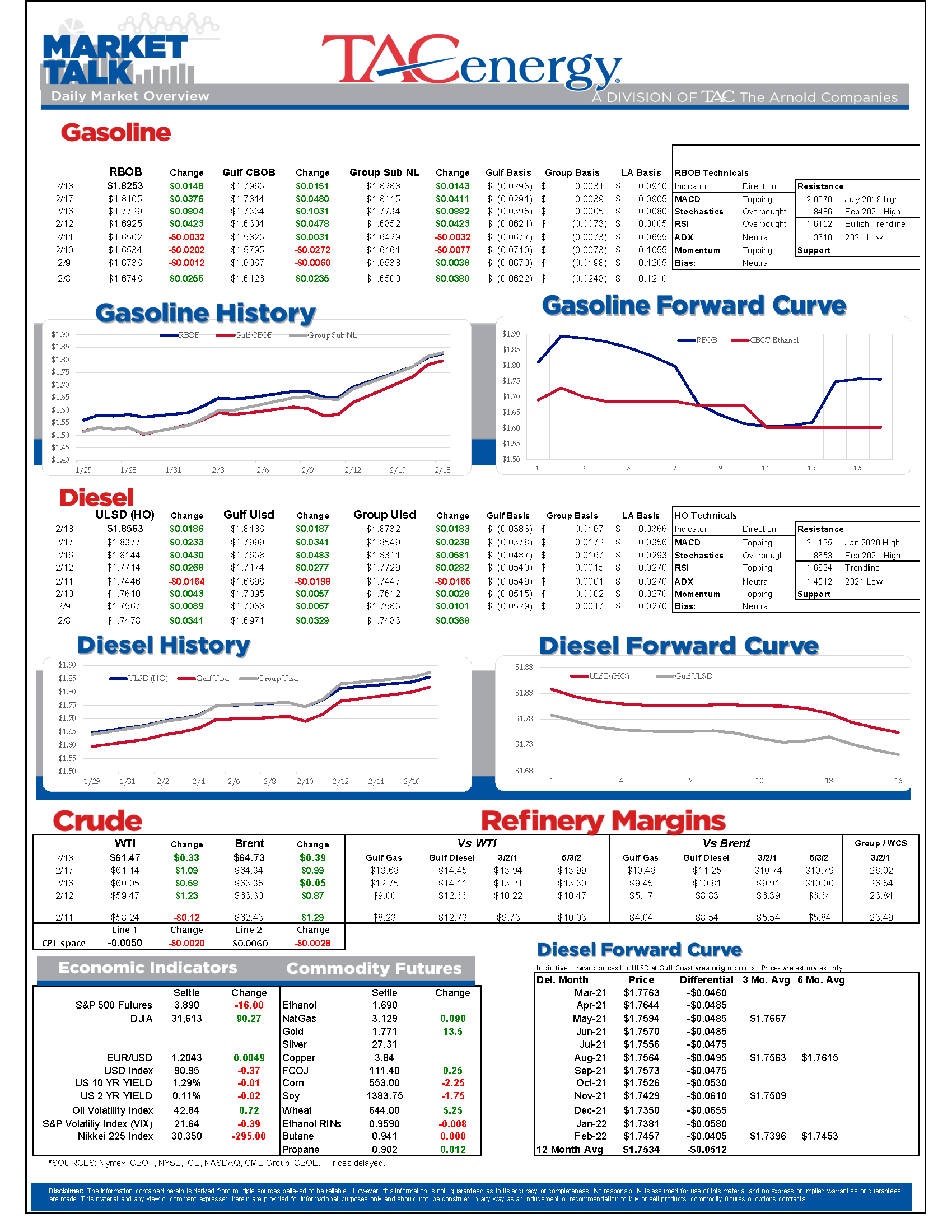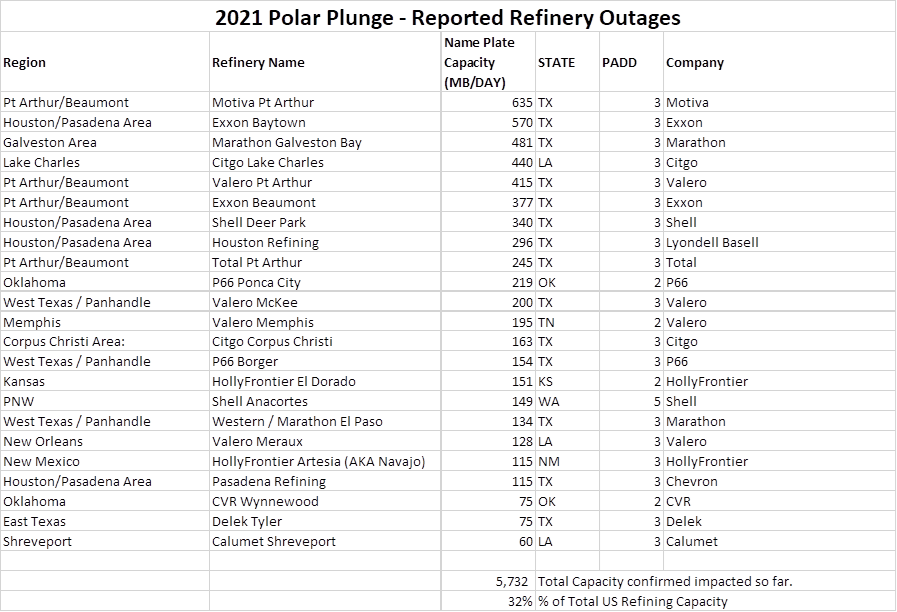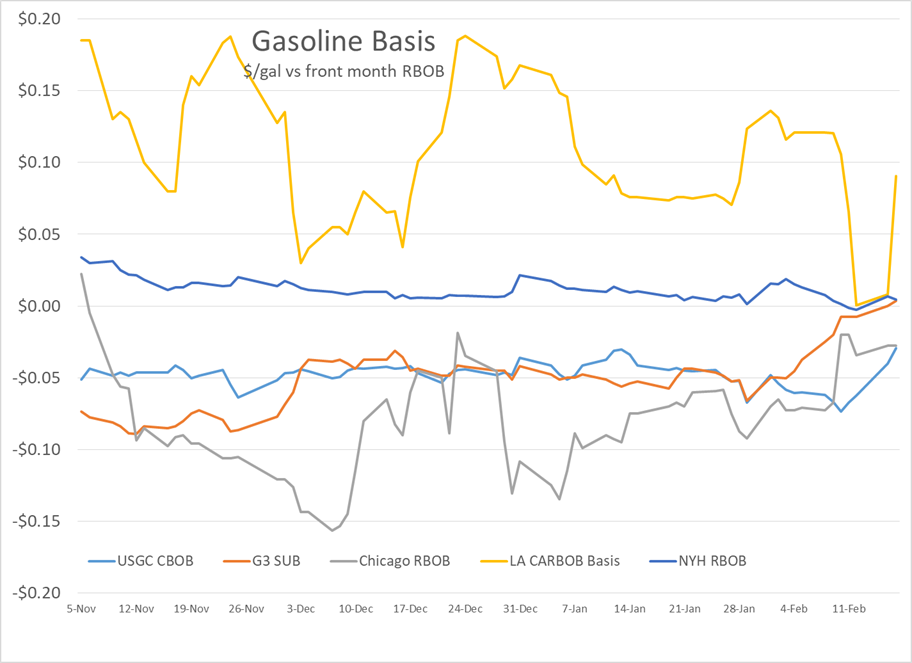How Long Until Power Comes Back On?

How long until the power comes back on? That’s the big question being asked by millions of people across the U.S. and Mexico, and a huge proportion of the energy industry as the remnants of a brutal stretch of winter weather moves East, and the thawing out process begins. In addition to the direct impact, the trickle down effects of the collapse in oil, refined products, natural gas and ethylene production are being felt around the world.
The refining hubs along the Gulf Coast from Corpus Christi to New Orleans have temperatures above freezing this morning, and should stay that way for the next week, except for a few hours tonight. If that thaw allows most plants to resume operations by the weekend, the impact of this chaotic event should be short-lived. Of course, the warm up also means that more drivers are about to hit the road, while terminals and stations that have been closed for a few days may or may not be able to come back online with supply, power and/or intact pipes to meet demand.
If you remember the panic buying in the wake of Hurricane Harvey, it’s not hard to imagine that the next few days could create a demand spike as news of the refinery shutdowns hits the mainstream just in time for people to start leaving their homes again, and could create a preventable panic phenomenon which could create supply shortages all on its own.
The Houston ship channel was able to resume limited operations after the ice blocking shipping lanes started to break up, a most unusual occurrence that may have some Texans reluctant to use the phrase “When Hell Freezes over” ever again.
We did see some heavy selling for about an hour Wednesday morning after a WSJ report that said Saudi Arabia was going to increase its oil output now that prices had recovered. That wave of selling wiped out the early gains for crude and product futures, but was fairly short lived and the march higher picked up later in the morning.
Basis markets continue to show strength for both gasoline and diesel grades across most U.S. spot markets, but those moves are still relatively minor compared to disruptions we’ve witnessed over the past two decades, a testament to the excess capacity in the U.S. and the softer-than-normal demand environment. In addition to stronger spot prices, numerous rack markets stretching from Arizona to Maryland have switched from seeing suppliers having to offer steep discounts to move product during the winter doldrums, to enforcing strict allocations as resupply options become questionable.
The API reported large draws in oil and diesel stocks last week, while gasoline stocks had another large build. The DOE’s weekly report is due out at 10 a.m. central today, and should give some glimpse into the impact on gasoline demand caused by the winter storms that battered the East Coast two weeks ago, that now appear quaint in comparison. Don’t expect the report to move the market much as last Friday’s data doesn’t mean much after almost 1/3 of the country’s refining capacity was forced to cut back this week.
In other non-frozen refinery news this week, Calumet laid out plans to convert part of its Great Falls Montana facility to Renewable Diesel production this week in an SEC filing, joining a long list of refiners looking to jump on the BTC/RIN/LCFS and new Canadian CFS programs that combined can offer more than $4.50/gallon in subsidies for RD production. The company also closed on the sale and leaseback of its Shreveport facility in an effort to save enough cash to survive the weak margin environment that was hammering refineries before the storms hit.
Great Falls Renewable Diesel Opportunity:
We believe Great Falls, which connects western agriculture with West Coast and Canadian clean product markets, presents one of the most compelling opportunities for Renewable Diesel production in North America. We estimate the oversized hydrocracker built in 2016 can be reconfigured to process 10-12,000 BPD renewable feedstock at the lowest capital cost per barrel of any announced industry project. Hydrocracker conversions are typically faster to market, cheaper, and less technically challenging. In addition, the planned configuration could retain 10-12,000 BPD low-cost Canadian crude processing, providing Montana customers with clean energy and our unique specialty asphalt. Future dual train operations are currently estimated to generate $220 to $260 million of Adjusted EBITDA assuming mid-cycle market prices and existing environmental market structure (BTC, RINs, LCFS).
Given strong investor interest in renewables, Calumet expects to utilize third party equity for this unique opportunity, without expending Calumet funds.
Click here to download a PDF of today's TACenergy Market Talk.
Latest Posts
Week 15 - US DOE Inventory Recap
Prices To Lease Space On Colonial’s Main Gasoline Line Continue To Rally This Week
Equity Markets Have Been Pulling Back Sharply In Recent Days As Inflation And Trade Concerns Inject A Sense Of Reality Into Stocks
Gasoline And Crude Oil Prices Reached Fresh Multi-Month Highs Friday Morning As News Of The Anticipated Attacks Spread
Social Media
News & Views
View All
Week 15 - US DOE Inventory Recap

Prices To Lease Space On Colonial’s Main Gasoline Line Continue To Rally This Week
Energy markets are sliding lower again to start Wednesday’s trading as demand concerns and weaker stock markets around the world seem to be outweighing any supply concerns for the time being.
Rumors continue to swirl about an “imminent” response by Israel to Iran’s attacks, but so far, no news seems to be taken as good news in the hopes that further escalation can be avoided, even as tensions near the Red Sea and Strait of Hormuz continue to simmer.
Prices to lease space on Colonial’s main gasoline line continue to rally this week, trading north of 11 cents/gallon as Gulf Coast producers still struggle to find outlets for their production, despite a healthy export market. Gulf Coast CBOB is trading at discounts of around 34 cents to futures, while Gulf Coast RBOB is trading around a 16-cent discount, which gives shippers room to pay up for the linespace and still deliver into the East Coast markets at a profit.
Back to reality, or just the start of more volatility? California CARBOB basis values have dropped back to “only” 40 cent premiums to RBOB futures this week, as multiple flaring events at California refineries don’t appear to have impacted supply. The state has been an island for fuel supplies for many years as its boutique grades prevent imports from neighboring states, and now add the conversion of the P66 Rodeo refinery to renewable diesel production and the pending changes to try and cap refinery profits, and it’s easier to understand why these markets are increasingly vulnerable to supply shocks and price spikes on gasoline.
RIN prices continue to fall this week, touching 44 cents/RIN for D4 and D6 values Tuesday, their lowest level in 6 weeks and just about a nickel above a 4-year low. While the sharp drop in RIN and LCFS values has caused several biodiesel and Renewable Diesel producers to either shut down or limit production, the growth in RIN generation continues thanks to projects like the Rodeo refinery conversion, making the supply in RINs still outpace the demand set by the Renewable Fuel Standard by a wide margin.
The API reported draws in refined products, 2.5 million barrels for gasoline and 427,000 barrels for distillates, while crude oil stocks had an estimated build of more than 4 million barrels. The DOE’s weekly report is due out at its normal time this morning.
Click here to download a PDF of today's TACenergy Market Talk.

Equity Markets Have Been Pulling Back Sharply In Recent Days As Inflation And Trade Concerns Inject A Sense Of Reality Into Stocks
It’s a mixed bag for energy markets to start Tuesday’s session with gasoline prices holding small gains, while oil and diesel prices show small losses as the world anxiously debates what comes next in the conflict, we’re still hoping we don’t have to call a war in the Middle East.
An early sell-off picked up steam Monday morning with refined products down more than a nickel for a few minutes, before reports that Israel was vowing to respond to Iran’s attack seemed to encourage buyers step back in an erase most of the losses for the day.
Equity markets have been pulling back sharply in recent days as inflation and trade concerns inject a sense of reality into stocks that had been flying high earlier in the year. The correlation between gasoline and crude oil prices had been fairly strong for the past couple of months but has since weakened as the weakness in stocks hasn’t yet trickled over into the energy arena. Both asset classes are seeing a tick higher in their volatility (aka Fear) indices this week however, and when fear starts driving the trade, we often see these prices move together.
Diesel has been underperforming the rest of the energy complex for most of the year so far, and those hoping for lower diesel prices got more good news when the Dangote refinery in Nigeria began loading diesel for domestic use Monday, in the latest milestone for the giant project that will have a major influence on Atlantic basin supply. Naturally, local lawmakers are already complaining that the refinery’s prices are too high.
The EIA this morning highlighted the record amount of crude oil China imported in 2023 after reopening the country post-COVID and after completing numerous new refinery builds in the past few years. Russia accounted for the largest increase in shipments to China last year, as China is one of the few countries that doesn’t mind ignoring sanctions. Speaking of which, the US House is expected to take up a new vote this week on sanctioning Chinese imports of Iranian crude, which the EIA notes are often hidden by relabeling the crude to make it appear as if it originated in Malaysia, Oman or the UAE.
We’re just 2 weeks away from the startup of Canada’s long-awaited Transmountain pipeline expansion that will bring roughly 600,000 barrels/day of capacity to the Pacific basin. That new outlet is great news for Canadian producers long restricted by takeaway capacity, and bad news for Midcontinent refiners who have grown accustomed to the discounted Canadian grades. A Bloomberg article Monday noted that Iraq’s Basrah Heavy crude is most likely to be displaced by West Coast US refiners who can now buy much closer to home.
Click here to download a PDF of today's TACenergy Market Talk.



